#w.h post
Text
🐤🎨⭐🎀: "YOU'RE IN LOVE WITH HOWDY?!?!"
🩺:"PLEASE DON'T YELL!!!"

Wanted to try drawing some of the other characters and thought this image was funny/cute in my head lol
((rip in pepperonis to my hand tho I did this all in one sitting and I'm paying the price for it 😭🙃))
#I don't think I did Poppy justice but I'm proud of this nonetheless!#welcome home#wally darling#poppy partridge#sally starlet#julie joyful#welcome home oc#dr. nancy#my character(s)#my design(s)#< i guess???#not really tho???#my art#welcome home au#might as well start putting this tag on my W.H posts
31 notes
·
View notes
Text
Baron Wormser: The System
Back in the day, I used to ascribe every woe to what I called “The System.” The woes were plentiful: war, the military-industrial complex that made the wars possible, racism, economic inequality, the global misery wrought by colonialism, the heavy hand of patriarchy, along with discrimination on various fronts. Since then I can add technological advents that have stirred the unhappy pot even…

View On WordPress
#Allen Ginsberg#Baron Wormser#Bob Dylan#capitalism#feudal#mill town#post-industrial#river#Simone Weil#The System#W.H. Auden#William Blake#working class
0 notes
Text
An early outline of AFFC written around 2003-04 by GRRM was recently shared on r/asoiaf. Read the original post here for more info.
Two entries are notes for Sansa POV chapters:
A)

SANSA
DIVIDE CHAPTER –
LF: CERSEI HAS OVERREACHED
SHE'LL SOON BE DONE
LF of course stands for Littlefinger.
B)

SANSA
?OLD - RESOLVE TO BE SS & TAKE NORTH
1 - TOURNEY OF WINGED KNIGHT
2 - SWEETROBIN [WOOS? WEDS? unclear]
3 - NEWS FROM W.H.
KILL THE MOUSE
④
SS very likely stands for Sansa Stark, and W.H. for White Harbor. The mouse of course refers to Ser Shadrich.
The people at r/asoiaf who transcribed GRRM's handwriting favor the reading 2 - Sweetrobin *woos, but *weds is also possible, as well as *wees although less likely.
The circled 4 seems to indicate the then total count of Sansa POV chapters that GRRM had already written drafts of (3) plus one he was planning on writing (already partially written).
As for what can be inferred from all this... The first note almost certainly became AFFC Alayne II. The second one seems to concern an unpublished chapter or chapters that GRRM moved to TWOW. Given it's been twenty years since he wrote this outline, this raises the question: does he still intend to follow this note? Assuming he does, there are some things we can extrapolate and speculate on:
Sansa will not lose herself into the Alayne persona, and is soon heading North to reclaim her identity and Winterfell/the region for House Stark.
The tourney of winged knights is mentioned in the TWOW Alayne I preview from 2015, so this indicates GRRM had the idea for it for at least a decade prior.
Interpretation of the line regarding Robert Arryn is dependant on the reading. If it's *woos it might refer to Robert's infatuation with Alayne, which we've seen in Sansa's last published chapter, AFFC Alayne II, and in the TWOW Alayne I preview from 2015. If it's *weds... the most straightforward reading would be that Robert marries someone, even potentially Alayne/Sansa. Considering Petyr's plans for rulership of the Vale which he reveals in AFFC Alayne II, both scenarios seem surprising.
News from White Harbor most likely refers to news of Ramsay's wedding to Arya Stark. There's no telling whether that includes the crucial detail that the bride is truthfully Jeyne Poole. Another option could be news of the mutiny at Castle Black and some kind of update on Jon, whether that's his death, his speculated resurrection or confusing reports about both and whether he was ever dead at all. Of course, the news could be a mix and match of all of this, too. Any of these options could be the catalyst for Sansa going North.
The strikethrough could indicate these ideas were either moved elsewhere or dropped entirely. Or perhaps GRRM returned to this page a second time and was denotting progress by crossing out passsages he'd since written/included in drafts?
Finally, kill the mouse either indicates that Sansa herself will kill Ser Shadrich or that his death will be featured in a Sansa POV chapter.
I admit I am not super knowledgeable when it comes to GRRM's interviews or any information outside the published novels, so if you're aware of anything that's been revealed in the past that might shed light on this outline, please share.
#sansa stark#asoiaf#valyrianscrolls#ssm#ssm originals#topic: speculation#tbc: reclaiming her identity as sansa stark#tbc: shadrich's quest to ransom sansa#tbc: house stark rule and the northern succession#quotes by grrm
125 notes
·
View notes
Text








Wild Geese by Mary Oliver / artwork by deactivated user @/emlynns / a picture I took a long time ago / this is just to say by William Carlos Williams / Cosmos by Leah Gardener / breathe gif from that anxiety tumblr post / Baymax from Big Hero 6 / The More Loving One by W.H. Auden / Slow Down by Laufey / On the Radio cover by Chip Taylor
ily nia pt. 1
for @begaana
9 notes
·
View notes
Note
is your old NSFW side blog still active?
Yes
@leatherlacelux
Also have my website blog but tbh I haven’t posted on it in awhile… I will eventually though
5 notes
·
View notes
Text












Vote for your favourite, the top 9 will proceed in the bracket. Since theyre all different shapes and sizes, make sure to click into the full views!
Paget Eliminations
Other Artist Eliminations
Full captions and details for each illustration below the cut:
"Two men came down the garden path." W.H. Hyde, Reigate Squires (Harper’s Weekly)
Characters: Cunningham Sr, Alec Cunningham
"Colonel Moran sprang forward with a snarl of rage." FD Steele, Empty House (Collier’s)
Characters: Police, Sebastian Moran, Holmes
"He picked up his hunting-crop and struck Napoleon." FD Steele, Six Napoleons (Collier’s)
Characters: Holmes
"The queer thing in the kitchen." FD Steele, Wisteria Lodge (Collier’s)
Characters: PC Walters, Sgt Baynes, Holmes, Watson
"We ascended the stairs and viewed the body." Gilbert Holiday, Devil's Foot (The Strand)
Characters: Holmes, Watson, Brenda Tregennis
"You'll only get yourself hurt," said the inspector. "Stand still, will you?" Walter Paget, Dying Detective (The Strand)
Characters: Holmes,Watson, Culverton Smith, Lestrade
"Give it up, Jack! For my sake - for God's sake, give it up!" Frank Wiles, Valley of Fear (The Strand)
Characters: Douglas/McMurdo, Ettie Shafter
"The wife was found in the grounds, late at night, with a revolver bullet through her brain." Alfred Gilbert, Thor Bridge (The Strand)
Characters: Maria Gibson
"The woman turned her flushed and handsome face towards me." HK Elcock, Sussex Vampire (The Strand)
Characters: Dolores, Robert and Mrs Ferguson
"The Adventure of the Three Gables" FD Steele, Three Gables (Liberty)
Characters: Holmes
"I turned over the paper. This never came by post, where did you get it?" HK Elcock, Lion's Mane (The Strand)
Characters: Maud Bellamy, Holmes, Ian Murdoch
"Holmes had lit his lantern." Frank Wiles, Shoscombe Old Place (The Strand)
Characters: Watson, Holmes, John Mason
12 notes
·
View notes
Text



19th February 1972 saw the death of John Grierson, the film director and producer.
John Grierson was born in Perthshire, son of a local school headmaster. He studied philosophy at Glasgow University, but was drawn into film-making through post-graduate study in the US on the influence of mass media on public opinion.
His ground-breaking work on the Scottish herring fleet, Drifters, had its premiere in 1929 alongside the first British showing of Eisenstein’s Battleship Potemkin. In 1936, he produced the celebrated Night Mail, directed by Harry Watt with script by W.H. Auden and score by Benjamin Britten.A prolific director and producer, he was particularly influential through his creation of film units within the Empire Marketing Board and the Post Office, nurturing a whole generation of documentary makers, including Edgar Anstey, Sir Arthur Elton, Stuart Legg, Basil Wright, Harry Watt and Cavalcanti. Among his many achievements, John Grierson established the National Film Board of Canada during World War II, and served as UNESCO’s first Director of Mass Communications and Public Information in 1947. Throughout his long career, he was in some way responsible for the production of well over 1000 films and television programmes.
Grierson’s influence on factual film-making was immense, underpinned by a strong social commitment. Of this he said: “The basic force behind documentary was social and not æsthetic. It was a desire to make a drama out of the ordinary, to set against the prevailing drama of the extraordinary: a desire to bring the citizen’s eye in from the ends of the earth to the story, his own story, of what was happening under his nose.” In fact he came up with the word documentary for this type of film.
The documentary (especially on television) has gone through many stages of creative development since he died, but he left behind a legacy in the many film-makers who dominated the British factual film (and BBC television) after the war. It could well be argued that the special place of excellence enjoyed by British television today owes much to that tradition, which was available to make movies when the BBC only had radio experience behind it.
This is not to say that Grierson did not generate an element of mythology, fuelled at times by some of his colleagues, he thrived on being centre of the stage, was a shrewd publicist for his own causes, self-interested, brutally blunt about his colleagues, and a great performer in projecting a carefully cultivated image. But if he perfected this style in raising his own stature, he did it for worthy and sincerely supported causes. Without it, he could never have succeeded in making governments, industry and bureaucrats finance the schemes and the films which created the documentary movement and it is said his influence and enthusiasm spread everywhere.
Much more on Grierson here
8 notes
·
View notes
Text

In notes to W.H. Auden's review of Return of the King, Tolkien wrote, "The theatre of my tale is this earth, the one in which we now live ..." Middle-earth, being a world much like our own, is home to a wide range of characters. In addition to fantasy peoples and creatures that populate Tolkien's imagined world, because Middle-earth is an analogue of our Earth, there would have been diversity within those groups as well, much like in our own world. This month, we’re shining a spotlight on as many character groups as we can fit in—and to be honest, we ran out of space. We hope there is something for everyone in this month’s prompts!
The Middle-earth Is Multitudes challenge will feature two new prompts every day, recognizing the diversity of the people who inhabit Middle-earth. One prompt will focus on a group within Middle-earth, while the second prompt will focus on additional identities or characteristics.
You do not need to complete a prompt on the day it is featured.
You can complete one prompt or both, and you can combine prompts from different days.
Fanworks can but do not need to center on the character's identity; the bigger aim of this challenge is to include more diverse characters in our fanworks in a variety of roles, not only in fanworks that focus on that particular identity.
We expect there will be overlap between prompts and want to encourage participants not to overthink if a particular character meets a prompt. If you think a person belongs in a particular group, that is good enough for us.
Several other Tolkien fandom events are or will be running while this challenge is active. With this in mind, we've intentionally designed this challenge so that it is easy to combine with other prompts from other events.
In order to receive a stamp for your fanwork, your response must be posted to the archive on or before 15 April 2023. For complete challenge guidelines, see the Challenges page on our website.
45 notes
·
View notes
Text
In other news- look who finally arrived.
(Also, I'm turning reblogs off on this cause again 1. I'm not comfortable sharing him and dont want others gushing on a personal post. 2. I'm tired of having to message people to delete their reblogs when I state in the tags, "Please do not reblog." 3. I'm not gonna tag the W.H. fandom tags either cause I would rather distance myself from after how I've seen a majority act. Please respect this.)
I was told you were going to show up next year, mister. Is the reason why I'm so tired because you've stolen some of my energy to get here sooner?? Silly.

8 notes
·
View notes
Text
Tagged by @idolsgf to post quotes from an OC's pinterest board.
Well I was tagged by @shivunin as well but since the tags are two I'm taking the chance to do it twice.
Because ironically, I was caressing the idea of starting a tag game of poetry associated with characters, LOL I may also have already written the post.
I don't use Pinterest much for quotes, so starting with Aisling who's the most complete one...








W.H. Auden, "The More Loving One" | Christina Rossetti, "Mirage" | Sylvia Plath, from a letter to Aurelia Plath | Anais Nin, "The Diary of Anais Nin, vol. 4, from 1944 to 1947" | Anais Nin, "A Journal of Love": The Unexpurgated Diary of Anaïs Nin, 1934-1937" | Rainer Maria Rilke, "Go to the Limit of your Longing" | Florence + the Machine "Queen of Peace" | Altan, "Gleanntáin Ghlas Ghaoth Dobhair"
Translation from the Irish (not by me, I go as far as knowing a handful of words. I found it here, if you know Irish and can see it's not accurate, please let me know and I'll edit this post asap!)
Farewell, farewell to Donegal
That county sweet and fair
And to her brave men when the enemy came
Never cowered or bowed to the Gall
I hold in esteem all those women and men
And all children big and small
That dwell there in peace without worry or grief
In Gleanntáin in Ghlas' Ghaoth Dobhair
Tagging (just on this, tell me if you'd like to be tagged to see the other one tho): @salsedinepicta @peromy-march (because we talked of Anais Nin and maybe you'll like doing this for your blorbos) @coloricioso @dungeons-and-dragon-age @herearedragons @eowyn7023 and YOU who are reading.
(Everyone got tagged already... If you want a second tag, say Friend and enter.)
#long post#tag game#characters quotes#aisling lavellan#mo you're absolutely right music definitely counts#I don't now if you can see a theme but if you do please let me know ahahahahahah
15 notes
·
View notes
Text
W.B Obbly's Obelisk Observer Society ( @gargoyle-doyle )
Timeline of the obelisk throughout the ages :-) get cozy this is a big long post :0
All of these are dated either by the original sources of the images or by us, through cunning cleverness and wild assumptions. Thanks for tolerating our inaccuracies and please feel free to point out anything you think is a mistake! I will site as many of the sources that I can track down in our files without losing my mind, if i left one out it's for your own safety (it was probably an accident). For the images that are really small I will include zoomed in/circled versions at the bottom of this post :-)
(this is not all of the images we have of the obelisk, just the ones that are relevant enough to give an idea of what it looked like/ where it was throughout the 1, 1/2 centuries it was on Southsea beach)
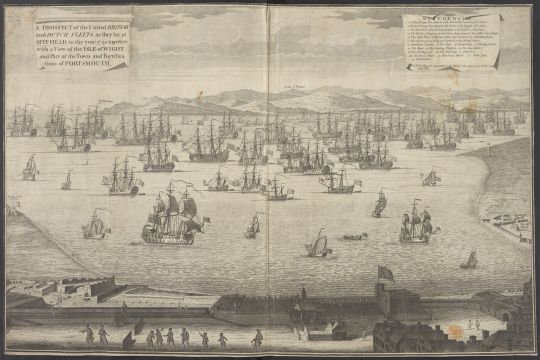
This drawing is dated 1729, and (I'm not sure if the quality is going to be butchered when I upload this) but there is a *tiny* little wooden post towards the left of the water which is listed in the written key as "6 Felton's Gibbet who stab'd the D of Buckingham". (scroll to bottom for zoomed in ver)

1765: listed as "10. Feltons Gibbet" and is the post of wood in the near centre of the image. (zoomed in version at bottom :3) one source says that this image (or one very similar) is from 1750 instead. Believe whichever one you want :))
The gibbet post was replaced with the obelisk sometime around 1782
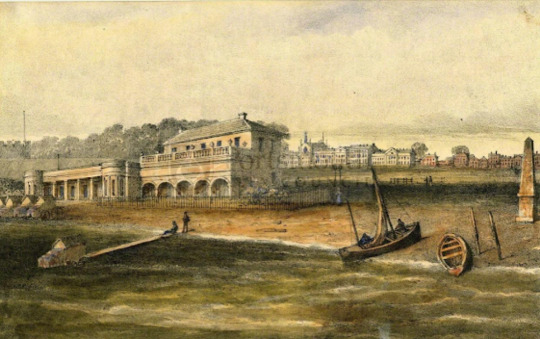
(est) 1830's: we got this image from the Portsmouth Historic Environmental record on their facebook and they had it listed as around the 1830's. Our obelisk is (most likely) the one on the right.
Around the 1850's onward things become really confusing and, in our files, very disorganized.
Southsea esplanade was built around 1852, along with Clarence pier around 1860. We think that the obelisk was moved during this construction (not very far, just further inland) along with the other monuments along the beach.

According to this Hampshire Telegraph from 1884, W.H. says that it was sometime around 1850 that Frederick Fitzclarence added the inscription on the obelisk, commemorating the construction of the esplanade. Among the other things Fitzclarence was doing to 'make his mark' on Southsea beach, he added two monuments dedicated to the Duke of Wellington and Admiral Lord Nelson which also went missing - might be W.B. Obbly Society's next research task :))
Then there's This link: H. Percy Boulnois says that "Amongst other improvements which I carried out along the sea front was the re-arrangement of the various monuments" so potentially he had something to do with the obelisks obscurity during this time period. I'm not too sure but I think this is sometime in the mid 1880's seeing as he was elected borough engineer in 1883 (I recommend reading the History in Portsmouth page linked above because it's super interesting; he also built Canoe lake and was friends with Arthur Conan Doyle - although it seems like there were very few people who weren't friends with Arthur Conan Doyle during his time in Southsea)
Anyways, all of this ^ was just to say that we have a few drawings that I might make a separate post about (I will link it here if I do ;) but I'm not adding them to this timeline because we can't even be entirely sure that the obelisk is in them.

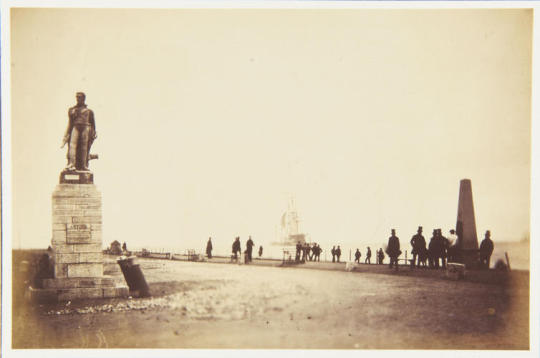
These two photos are the first photographs we have of the obelisk! Both are dated from 1854 and found on the royal collection trust site. The first one is titled "The fleet at anchor" and the second one is titled "The Neptune coming out of harbour" and also shows either the Wellington or the Nelson monument as well.
Even though I said I was going to make a separate post about this, I'm terribly unreliable and lie constantly so here's one of the drawings that confuses us from around the 1850's:

This is one of the many drawings we have with a wacko looking version of the obelisk, so wacko that we can't even really tell if that is the obelisk in the background. My current theory is that artists who drew Southsea beach hated drawing the obelisk so they just took as many creative liberties as possible to make it look completely unrecognizable. But given the placement in comparison to the 1854 photos where the obelisk is literally visible ??? still can't be too sure honestly lets just move on before I get upset
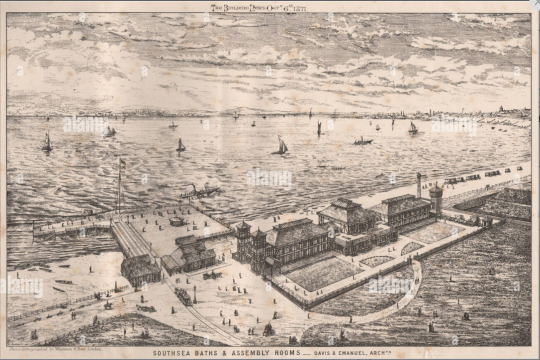

The only date that I can find for these two drawings is 1871, both from alamy images, the obelisk would be one of the structures near the 'street' in the bottom left. In the second image it looks like it has been removed for construction? (also clearly visible in the second image is the bases of the Wellington and Nelson statues on either side of the tramlines - which is interesting as neither of the actual statues themselves are there despite the fact that according to their memorial page the Wellington statue remained in place at least until 1874? This means one of these sources is wrong and I'm out to find out which one >:-( if anybody is even reading this and happens to know something pls tell me imbegging
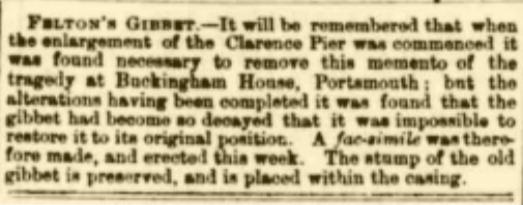
In 1881 there is this newspaper extract (Hampshire Chronicle Feb 5th 1881) that claims the obelisk was removed for construction and found to be too decayed to be re-erected so instead it was replaced by a fa-simile. RIP to the original obelisk :(
Another article from 1881 says that the new obelisk was painted brown instead of white because people thought the original white looked moldy and gross (lol)
We still have photos from after the article where it still appears white, but honestly it's colour varies a lot so whatever

1892, obelisk is the white structure in the centre of this photo

1894, I think the obelisk is just barely visible in the shadows to the left of the pier
Between the 1890's and the 1930's we have a sad gap in our photo collection BUT there are plenty of newspaper extracts that mention the obelisk so we know it was definitely still there during this time period, I won't include all of them as I'm planning on making a separate post dedicated to the newspapers mentions. (acquired through our buddy David who gave us access to the online newspaper archive)
*we do have one photo estimated from 1900 which i've added at the very bottom of this post
The most notable newspaper entry from this time period is Feb 22nd 1902 and it says that the obelisk was blown down in a storm. (sorry its blurry)

We know that it was at least rebuilt by 1915 which is its next mention in the papers.

1930: This image is from the evening news March 13th, 1930. This is a photo that we would kill to find the original version of, as it is maybe our best bet of getting a good look at the inscription. I'll probably go into more detail on a separate post.

1934, from a newspaper article signed "W.G." that we think was written by William Gates based on the monuments and memorials website.

Skipping to this image dated "1930's" that I found randomly in one of my textbooks while I was doing my geography homework, which just happens to be one of the best images with have of the obelisk from this era. My best guess is that this is mid - late 1930's (based on absolutely nothing other than intuition and the cars in the photo) Thank you to my geography teacher for assigning local sea defense's as a research task as it led me to the Southsea coastal scheme booklet :)

1937, there are a lot of photos just like this one from old Southsea postcards with the obelisk far in the background but this is the only one I have with a specific date - thus making it timeline worthy

We have this image dated as 1939, making it the most recent photo we have of the obelisk so far. Portsmouth music scene website has a really similar image of the pier (scroll wayyy down on that link), with the sign advertising "Hugh Frossard and his broadcasting band", who performed at clarence pier in June 1939.

The zoomed in images ! sorry these are still kind of blurry

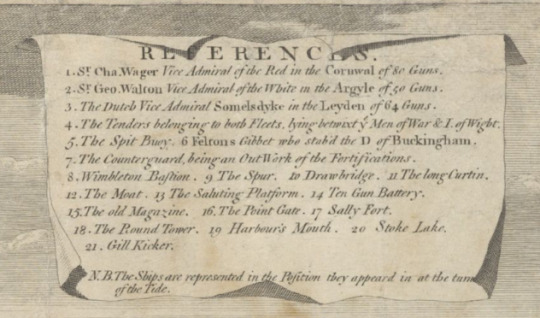

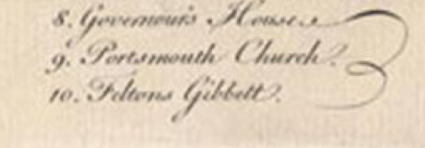

(this is a black and white version of the 1894 clarence pier pic because you can see the outline of the obelisk better)

Bonus images!! I dont have specific dates for these two but I really like them :-))

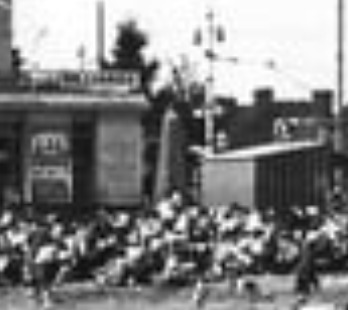

*This is the one estimated around 1900, but I can't remember where I found this image/where I got that date from which makes me suspicious
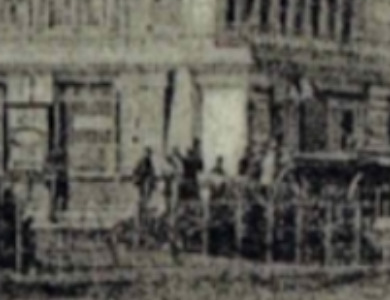
It's also super hard to see the obelisk in the background but here's the best close up I can get you
Bye!!
12 notes
·
View notes
Text
List of poets whose work I've posted:
Poetry Magazine selections
The Adroit selections
Diode Poetry selections
Sixth Finch selections
Ada Limon
Adam Zagajewski
Adonis
Allen Ginsberg
Amy Clampitt
Andrea Cohen
Anna Akhmatova
Anna Swir
Anne Sexton
Ben Johnson
Billy Collins
Cathy Linh Che
Carolyn Marie Rodgers
Chard deNiord
Christina Rossetti
Czesław Miłosz
Dalton Day
Denise Levertov
Dian Million
Donika Kelly
Dorianne Laux
Edward Hirsch
Elizabeth Bishop
Elizabeth “Sister Goodwin” Hope
Ellen Bryant Voigt
Gloria Bird
Gregory Orr
Gwendolyn MacEwen
Henry Wadsworth Longfellow
Jack Gilbert
James Hayford
James Longenbach
Jenny George
Jim Harrison
Joanna Newsom
John Berryman
John Dowland
John Keats
Jorie Graham
Joy Harjo
Kitchen McKeown
Kuhu Joshi
Langston Hughes
Linda Pastan
Lisel Mueuller
Louise Glück
Mary Karr
Mary Oliver
Mary Tallmountain
Matt Hohner
Matt Rasmussen
Matthew Arnold
Michael Gray Bulla
Miles Walser
Morag Smith
Natalie Diaz
Ocean Vuong
Penny Shutt
Phil Ochs
Phillip B. Williams
Robert Hedin
Roberta Hill Whiteman
Ronald Wallace
Ruth Stone
Sayat Nova
Sherman Alexie
Stephen Kampa
Sugawara no Michizane
Thomas Lux
T.S. Eliot
Wanda Coleman
W.H. Auden
William Carlos Williams
Will Alexander
Wisława Szymborska
When the Light of the World Was Subdued, Our Songs Came Through: A Norton Anthology of Native Nations Poetry
15 notes
·
View notes
Text
In Old Cincinnati, Nights Before Halloween Were Packed With More Tricks Than Treats
These days, Halloween seems to kick off sometime just after Labor Day and drags on into the first week of November when the seasonal candy goes on sale and the fake spider webs sag under a load of soggy fallen leaves. In the old days, however, Halloween was restricted to two or three nights and the emphasis was on “trick” rather than “treat.” The Cincinnati Post [27 October 1922] carried the schedule for St. Marys, Ohio:
“Mayor W.H. Swift and Tony Johns, police chief, say the boys can have a good time on these nights if they don’t destroy property. Oct. 29 is to be ‘Cabbage Night;’ Oct. 30, ‘Corn Night;’ and Oct. 31, Hallowe’en.”
Let us, for the moment, leave aside the fact that this invitation was addressed only to boys, and focus on those additional nights. What was Cabbage Night? What was Corn Night? And, depending on where you lived in the United States, what was Gate Night, Goosey Night, Devil’s Night, Tick-Tack Night, Mischief Night, Beggars Night, Trick Night and Damage Night?
Donald E. Weaver, assistant city editor of the Cincinnati Post, explained Corn Night in a reminiscence published on Halloween 1930:
“Corn Night was the last night before Halloween. The kids threw shelled corn against the windows, rang doorbells and soaped a few windows.”
Weaver describes a ritual week of various mischief-breeding nights, beginning with Tick-Tack Night and ending with Halloween. A Tick-Tack (or Tic-Tac) had nothing to do with bad breath. It was a device built around one of Mom’s old sewing spools, screwed onto a long stick so that, when the miscreant pulled a string wrapped around the spool, it sounded like someone rapping on the window. It was the same principle as Corn Night, only louder.
Gate Night is somewhat self-explanatory when you picture the bygone neighborhoods of yesteryear, each little yard surrounded by a picket fence. As Weaver explained:
“The next morning was apt to find Squire Hickey’s gate hangin’ from the belfry of the Town Hall.”
Goosey Night wasn’t much celebrated in these parts, being almost entirely confined to the New York and New England region. The origin of the name is disputed, but most authorities believe it has nothing to do with poultry, and more to do with ghosts. It was a night devoted to scaring nocturnal pedestrians with noisemakers and eerie lanterns.

Mischief Night and Trick Night pretty much define themselves. Nights carrying those formal names were mostly celebrated eastward from here, but the spirit spread throughout the Cincinnati area, as Editor Weaver recalled:
“Widow Green’s cow got so used to being put queer places on Halloween she didn’t seem to mind. But Widow Green, she took on somethin’ terrible, especially the time the boys crowded Flossie into Biddy Harmon’s henhouse, ‘cause Widow Green and Biddy hadn’t spoken for years.”
Cincinnati lies at the southern fringe of an area in which Devil’s Night is observed. The real hotbed of Devil’s Night activity is in Michigan, especially around Detroit where, in some years, the riot squad had to be called out to quell disturbances that fell just shy of urban warfare.
So, how did cabbages get mixed up in all this rowdy mischief? To explain, we must return to the question of gender discrimination and the nefarious suppression of women by the patriarchy. While their brothers and potential boyfriends were out soaping windows and stealing gates, in other words, “having fun,” proper young ladies observed Halloween by attempting to determine who would become their future husbands. One guaranteed method involved cabbages. Don Weaver, apparently ignorant of the matrimonial aspects of the family Brassicaceae, reports only on the mischievous aftereffects of the cabbage ritual:
“The next night after Tick-Tack Night was Cabbage Night, when they swiped what cabbages were left in the gardens, and tossed ‘em onto front porches.”
Not so fast, Donny Boy! Way back in 1875, a correspondent to the Cincinnati Times, who signed his article only with the penname “Nepenthe,” gave the real story:
“Imagine the young belles of our city arrayed in their most-tied-backest evening suit en traine, and the beaux in their lavenderest pants, spotless diamond decked shirt-fronts, and faultless swallow-tailed coats, tripping out into the nearest Mill Creek garden, groping about among the protecting fodder for a cabbage-stalk, which, upon being brought under the gaslight, will presage by its crookedness or straightness the character of their future life-partners.”
Having done its vegetative duty as a marriage predictor, of what use was the clairvoyant cabbage? Hence it was tossed upon the nearest porch, or the porch of one’s prospective father-in-law, perhaps.
Another scrying technique, employed by boys and girls involved three bowls. One was filled with clear water, another with either mud or ashes, and the third left empty. The three receptacles were laid out in a row on a table, the subject blindfolded and the bowls reordered repeatedly. The visually impaired supplicant then felt for a bowl and plunged his or her fingers into it. If they splashed clear water, they would marry a virginal spouse. If they touched the mud or ashes, they would marry a widow or widower. If they found the empty bowl, a lifetime of spinsterhood or bachelorhood awaited.
Why did these antique celebrations fade away? One reason is certainly the expansion of the Halloween season. It was rare, well into the 1950s, for adults to take any part in Halloween festivities. This was a spooky holiday for children only. The very idea of a “sexy nurse” costume was inconceivable. Pop-up Halloween stores that open shop before the Autumn Equinox are very much a modern development.
But the main reason these “mischief nights” are no longer commemorated has to do with active police suppression. During the 1930s, Cabbage Night destruction got completely out-of-hand. The Cincinnati Post [31 October 1940] reported incidents from the night before involving flaming barricades blocking streets and tying up traffic, tool sheds being set ablaze, gangs of ruffians driving around firing rifles at windows in occupied houses, all the windows of a school being broken, piles of garbage filling alleys, multiple cases of flat tires, and dozens of fist fights.
The 1960s brought escalated mayhem as “Mischief Night” evolved into “Damage Night.” The Enquirer reported several outrageous incidents the night before Halloween in 1963, including two serious grass fires in Indian Hill and a foot-deep crater blasted in the Kyles Lane entrance to I-75. In 1986, 59 automobiles had their tires punctured by Damage Night vandals in Brentwood. In other words, the stuff your parents described as “good, clean fun.”
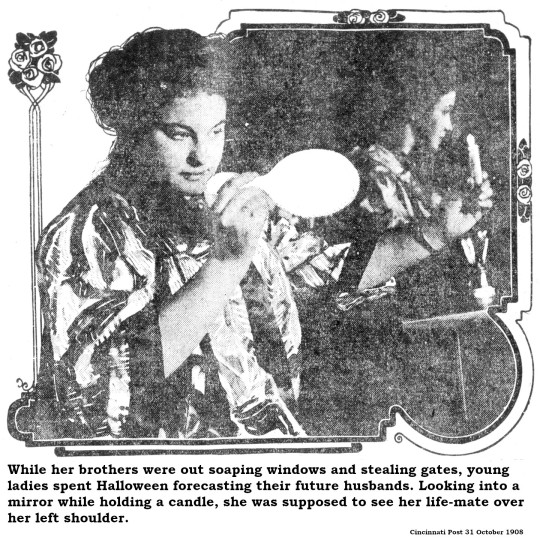
9 notes
·
View notes
Text

July
Prompt: Festival/Friendship
Quote: “If equal affection cannot be, let the more loving one be me.” - W.H. Auden
Lyric: Anything you want to say // I’ll be right here // I’ll listen so tell me
~ Belle/Kylie McNeill - “Lend Me Your Voice” (English Version)
Prompt released: June 22nd, 2023
Posting time: July 19th-21st, 2023
#rwby rosegarden#rgyear#rwby ruby rose#rwby oscar pine#rwby rg#rosegarden#rg#ruby rose#oscar pine#rwby ruby#rwby oscar#ruby x oscar#gngrbrd#rwby gngrbrd#rosepine#rwby rosepine#july
12 notes
·
View notes
Note
you posted this poem the other day that fucked me up (complimentary) 😵💫 do you have a favorite poet?
oooh which one?? there is nothing i love more than getting fucked up (or fucking other people up???) with poetry!!
i have way too many to name lol. if i had a gun to my head and had to say a single person, i think it's w.h. auden.
but audre lorde, linda gregg, edna st. vincent millay, mikko harvey, robert frost, and ada limón are all clamoring up there all the time. god and paige lewis. and w.s. merwin!!!
4 notes
·
View notes
Text
The Shade's Journal
In lieu of a letter column, James Robinson's run of Starman occasionally featured text pieces from the Shade's journal. As these are not included in the Starman Compendium or DC's digital versions, I wanted to type them up so everyone can experience such treasures as the Shade's love for dogs, Howard Hughes getting beat up, and Jack Knight's weird thing for mimes. All of these are written by James Robinson; the rest will come eventually, as will a compilation post.
Starman v2 Issue 2
FROM THE SHADE'S JOURNAL
The problem with immortality is the memories. Prolonged life means more events, which in turn means more recollections at a later date. And there are so, so, so many events to recall.
Today there was nothing much occurring that I felt warranted inclusion in my journals. David Knight patrols the nighttime streets, and the city is Opal City. For this reason, with my book open on a blank white page, and my pen in my fingers, I feel compelled to write of the other times. Times past.
I remember London. Visiting it for the final time. Visiting Oscar too, at his Tite Street home. This was long before his fall from grace, thankfully. We ate a fine cream tea that afternoon, and I think this was not the first for Oscar, as his waistline was more than beginning to show. Not that it really mattered to me; I merely pause now to reflect.
Our time together was a delight. I sat and listened mainly. Oscar's night before had been one of fine port and rakishness, so he was slow to start with his wit. But, of course, he started eventually. And I listened and laughed as Oscar commented on "this" public figure or "that" bit of scandal. Indeed, that week there'd been a salacious new tale about Catherine Walters. "Skittles" as she was known, was one of London's more famous "grande horizontales." There had been talk of her and W.H. Grace, the famous cricket player. Oscar made a remark about "Dr. Grace getting a sticky wicket" that had me doubled over with laughter.
I'd just begun to realize, then, that perhaps, just perhaps, I was no longer going to age. This fact had crept up on me. It was with shock I realized that the week prior I'd turned sixty and yet still looked to be in my late thirties. And that day was when it really sank in. Oscar was beginning to show those signs of a misspent life that should have been mine also. Seeing the signs of wear and tear in my friend made me sad. And a little ashamed. Guilty.
Yes, looking back, perhaps that was why I never saw Oscar again. It was 1891, years after we'd last met in Opal City during his American tour. And years before his troubles with Queensbury and all the dreadfulness that followed. Poor Oscar, perhaps I should have been there for him in '95. But like many other friends, I was nowhere to be found.
Anyway, Oscar's evening was to be spent with Lord Alfred whom he'd recently met. Oscar was charmingly firm in telling me that I was not invited to accompany them.
And so we were alone that night, London and I.
My mood and the wind both had a sharp sting to them, and one or the other bid me to venture forth to Tiger Bay, down by the Thames where the air was foul and all good folk know never to go. But I am not, nor ever was, a good man. And so I went.
The opium dens and drinking clubs were full, with sailors, and doxies and Orientals. You could hear any language in the work. You could see any color skin too. London has always been a melting pot, and on this night in Tiger Bay, the fire beneath that pot was burning fierce.
I walked into a deserted courtyard, on my way from one street to another, and there stumbled on a most singular occurrence: a large brown bear being clubbed to death by its owner. The beast was close to the end, from the many repeated blows his owner had given it with a sharp studded mallet. I inquired what terrible thing the beast had done, that it should be treated so, and the man replied that the bear was too old to perform anymore. The bear had been a street dancer and on weekends in Pitney Market and other parts, had made this fellow much coin. But now old, the bear was costing the owner more to feed than the animal brought in, and so the man and resolved to kill the beast and sell its flesh to the slaughterhouses.
Something about the scenario struck me as ludicrous. The man was small and weak, and yet had somehow overcome this huge animal and with no regard or affection was now ending its existence merely for aging. I think my guilt over Oscar's aging might still have been affecting me. Perhaps.
Whatever. I killed the man.
The reason I'd gone to Tiger Bay was that this had been where I was born. "I" being the Shade, of course. I had even then ceased to think of my "human" existence, before my transformation, as living. I suppose by returning to my roots, I'd thought to gain some inner peace. To this day the horror I witnessed during my creation and the countless deaths that occurred then still haunt me. Back in 1891, they were vivid and terrible, and I know I'd have done all and anything to end them.
But going back never allows one to go forward. That's a myth fashioned by poets. And I am no poet. All I got from my journey was sadness—the kind that grabs and clings and threatens to drag you down to the shadows of a dark place, where even I, who know much of dark places, am fearful to go.
It was as I turned back towards the city that I saw her, the final nail in the coffin that was my waning affection for London. The Victoria Match Factory employed over a thousand girls and women. The work consisted of tipping match sticks into phosphorus, which, after prolonged contact, caused the bones of the workers doing this to decay. The sight of beggar girls without jaws or fingers was a common one. "Phos girls," as they were known. And it was now that one such poor wretch approached me. The lack of a jaw prevented her from speaking, and instead she mewed plaintively, like a kitten. I had seen such girls before. I had seen them. And I had thought my heart hardened by it, that sight, and everything else.
Yet that night a tear fell from my cheek.
I gave the girl a guinea. More money than she'd ever seen, to be sure.
And I turned and walked from her and from London and from England. Never to return. Opal City had been my residence then, a place where I lived and went forth, visiting London and Paris and Gotham City. But from that moment on, the Opal truly became my home. My place in the world.
*****
It's been an hour since I wrote those last words. In that time, much has happened. I've enjoyed a rather good French wine; this, the perfect complement to my dinner of beef and oyster pie. Also, some lucky citizen of Opal City won seven million dollars in the lottery. And finally…David Knight, this city's current champion, has been less than lucky.
David Knight was murdered twenty minutes gone.
The reports are still vague, definite answers few, but it does indeed appear that David Knight has died. There's nothing I can do about it, of course. Until I know more, it would be unwise of me to attempt anything. And of course, there's the distinct possibility that I won't want to attempt anything, anyway. So for now, I listen to the news reports, and I think, and of course, in my present mood…
…I remember.
Few recall the Starman of the 1950's, but I do. He flew the night skies over Opal for a year and a week, and then died a brave death. Brave and foolish, Ted Knight was still intent on his research. He'd just developed the prototype Cosmic Rod, and I think his mind was wrapped up in furthering that work. He was recovering physically too, from injuries sustained in Washington. Indeed, thinking about it, he looked the worse from that for quite some time. And then he married also, and women will ever be the death of men's endeavors, so who can blame Knight for his time away from the cape and costume.
I've many theories on the identity of the champion who arose to take Ted's place in those days when the Starman of lore wasn't there for his city. Alas, the ultimate answer to that question is still one that eludes me. Perhaps Knight knows. Perhaps one day I'll get the opportunity to ask him. However, it was evident that the 1950's Starman had different powers and a different costume and bore no real relationship to the one before or any since. A riddle surely. A puzzle. Some love such twisted passageways, but I detest them.
I'll know the truth, the whole truth, one day. I will.
But for now I content myself merely to remember.
13 notes
·
View notes